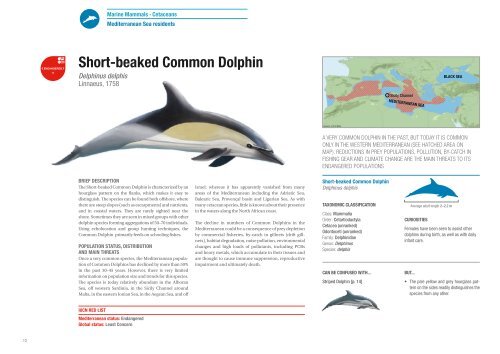Marine mammals and sea turtles of the Mediterranean and ... - IUCN
Marine mammals and sea turtles of the Mediterranean and ... - IUCN
Marine mammals and sea turtles of the Mediterranean and ... - IUCN
You also want an ePaper? Increase the reach of your titles
YUMPU automatically turns print PDFs into web optimized ePapers that Google loves.
.12<br />
<strong>Marine</strong> Mammals · Cetaceans<br />
<strong>Mediterranean</strong> Sea residents<br />
Short-beaked Common Dolphin<br />
Delphinus delphis<br />
Linnaeus, 1758<br />
BRIEF DESCRIPTION<br />
The Short-beaked Common Dolphin is characterized by an<br />
hourglass pattern on <strong>the</strong> flanks, which makes it easy to<br />
distinguish. The species can be found both <strong>of</strong>fshore, where<br />
<strong>the</strong>re are steep slopes (such as escarpments) <strong>and</strong> nutrients,<br />
<strong>and</strong> in coastal waters. They are rarely sighted near <strong>the</strong><br />
shore. Sometimes <strong>the</strong>y are seen in mixed groups with o<strong>the</strong>r<br />
dolphin species forming aggregations <strong>of</strong> 50–70 individuals.<br />
Using echolocation <strong>and</strong> group hunting techniques, <strong>the</strong><br />
Common Dolphin primarily feeds on schooling fishes.<br />
POPULATION STATUS, DISTRIBUTION<br />
AND MAIN THREATS<br />
Once a very common species, <strong>the</strong> <strong>Mediterranean</strong> population<br />
<strong>of</strong> Common Dolphins has declined by more than 50%<br />
in <strong>the</strong> past 30–45 years. However, <strong>the</strong>re is very limited<br />
information on population size <strong>and</strong> trends for this species.<br />
The species is today relatively abundant in <strong>the</strong> Alboran<br />
Sea, <strong>of</strong>f western Sardinia, in <strong>the</strong> Sicily Channel around<br />
Malta, in <strong>the</strong> eastern Ionian Sea, in <strong>the</strong> Aegean Sea, <strong>and</strong> <strong>of</strong>f<br />
<strong>IUCN</strong> RED LIST<br />
<strong>Mediterranean</strong> status: Endangered<br />
Global status: Least Concern<br />
Israel; whereas it has apparently vanished from many<br />
areas <strong>of</strong> <strong>the</strong> <strong>Mediterranean</strong> including <strong>the</strong> Adriatic Sea,<br />
Balearic Sea, Provençal basin <strong>and</strong> Ligurian Sea. As with<br />
many cetacean species, little is known about <strong>the</strong>ir presence<br />
in <strong>the</strong> waters along <strong>the</strong> North African coast.<br />
The decline in numbers <strong>of</strong> Common Dolphins in <strong>the</strong><br />
<strong>Mediterranean</strong> could be a consequence <strong>of</strong> prey depletion<br />
by commercial fisheries, by-catch in gillnets (drift gillnets),<br />
habitat degradation, noise pollution, environmental<br />
changes <strong>and</strong> high loads <strong>of</strong> pollutants, including PCBs<br />
<strong>and</strong> heavy metals, which accumulate in <strong>the</strong>ir tissues <strong>and</strong><br />
are thought to cause immune suppression, reproductive<br />
impairment <strong>and</strong> ultimately death.<br />
Short-beaked Common Dolphin<br />
Delphinus delphis<br />
TAXONOMIC CLASSIFICATION<br />
Class: Mammalia<br />
Order: Cetartiodactyla<br />
Cetacea (unranked)<br />
Odontoceti (unranked)<br />
Family: Delphinidae<br />
Genus: Delphinus<br />
Species: delphis<br />
CAN BE CONFUSED WITH...<br />
Striped Dolphin [p. 14]<br />
Sicily Channel<br />
MEDITERRANEAN SEA<br />
CURIOSITIES<br />
Females have been seen to assist o<strong>the</strong>r<br />
dolphins during birth, as well as with daily<br />
infant care.<br />
BUT...<br />
BLACK SEA<br />
A VERY COMMON DOLPHIN IN THE PAST, BUT TODAY IT IS COMMON<br />
ONLY IN THE WESTERN MEDITERRANEAN (SEE HATCHED AREA ON<br />
MAP). REDUCTIONS IN PREY POPULATIONS, POLLUTION, BY-CATCH IN<br />
FISHING GEAR AND CLIMATE CHANGE ARE THE MAIN THREATS TO ITS<br />
ENDANGERED POPULATIONS<br />
Average adult length 2–2.2 m<br />
• The pale yellow <strong>and</strong> grey hourglass pattern<br />
on <strong>the</strong> sides readily distinguishes <strong>the</strong><br />
species from any o<strong>the</strong>r.

















